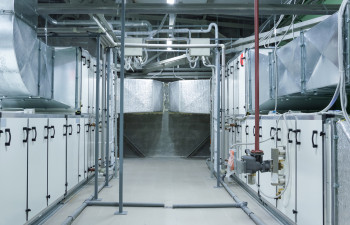All you need to know about air handling unit filters
Air handling unit (AHU) filters are a crucial part of any AHU and without them, the air quality in many indoor environments would be seriously compromised. An AHU is used to renew the air through a ventilation and air conditioning system installed within a range of buildings, such as offices, workshops, or warehouses.
Whether they are large modules installed on the roof of a building, or a residential air handling unit, there are a variety of different filters available to suit for a number of variables. These can include the room capacity (measured in square metres), the type of air to be cleaned, and if the end result is for industrial, commercial or residential use.
What are the parts of an AHU?
An AHU is comprised of a series of parts and functions that combine to draw outside dirty air and to draw in fresh air. The parts are:
- Air intake – The AHU draws in outside air to be treated and distributed indoors once it has passed through the AHU’s filters and cleaned.
- AHU filter – The filter traps the particles and pollutants in the air, depending on the type of filter used and what is contaminating the air.
- AHU fan – The fan pushes the clean air out of the AHU through the ventilation and air conditioning ducts to distribute the fresh, cleaned air into the building.
- Heat Recovery System – This part allows to pre-heat fresh air in winter.
- Cooling coil – This cools the air as it passes through the system.
- Silencers – AHUs can be rather noisy, so silencers reduce the noise from loud elements of the AHU when it is operating.
- Plenums – These boxes bring in, remove and distribute air.
How does an AHU work?
An AHU is an efficient way to improve air quality within buildings. As part of a ventilation and air conditioning system, they are designed to clean and circulate fresh air to ensure a healthy environment for inhabitants.
AHUs draw air in from outside, push it through filters that trap the pollutants in the air before a fan pushes it through the ductwork in the building to distribute clean, fresh air indoors.
The cooling and heat exchangers built into AHUs are used to increase the capacity of the AHU and to save energy. In some cases, air handling units can draw in air from rooms and re-circulate it, which reduces the level of energy used further.
A key part of the process in cleaning the air is the filters used to remove the pollution, particles, and other contaminants, such as viruses and bacteria. There are different filters available depending on how the AHU is going to be used and what needs to be filtered from the air.
How do you select filters for your AHU?
This depends on where and how the AHU will be used. For example, the air pollution in a manufacturing facility is going to contain different size particles to that of residential homes. Today’s urban air quality is polluted by smaller particles and gases that are generated from outdoor pollutants, i.e., from diesel and combustion engines. This means that the air filter selected needs to be able to remove the smaller particle sizes, as well as fungal and bacterial spores, to provide better indoor air quality.
Manufacturing industries usually require a different type of AHU filter to hospitals, for example, because of the type and size of the particles that need to be removed from the air.
You will also need to consider the efficiency rating of the filter.
The effectiveness of a filter is measured according to standard ISO 16890. Generally, filters can trap particles ranging in size from 10 microns down to 0.3 microns.
What are the filter types?
There are several types of filters available for AHUs:
- HEPA filters
- Bag filters
- Panel filters
- Electrostatic filters
- Carbon filters
- HVAC air bag filters
Bag filters
The most common type of filter is the bag filter, which consists of 4 to 12 bags laid parallel to each other. The length and depth can vary — from 300mm to 900mm — and they can range from low-efficiency coarse filters to very highly-efficient fine filters, depending on the thickness of the filter material and the number of bags used. The bags can either be tapered to enhance airflow or straight.
Bag filters remove dust from the air through a series of processes including sieving, inertial collision, hooking, diffusion, gravitational sedimentation and static electricity.
This type of filter is normally used to capture harmful and poisonous gases, as well as related dust particles that are emitted in industries that manufacture cement, glass and fertiliser.
Compact filters
Comprised of pleated panels mounted in a rigid frame, compact filters come in a variety of shapes. They are made to a depth of 292mm and use wet-laid micro glass or synthetic fibre pleated into a filter pack. When sealed into the frame, they form a V shape which provides the maximum level of filter. The pitch and height of the pleat, the surface and the number of Vs determine the filter performance and quality.
Pleated panel filters
This type of filter is used to extend the life of the filter media, enabling the air velocity through the filter medium to be much lower than the face velocity, creating the right efficiency at an acceptable drop in pressure. The pleated panels are made from a blend of synthetic polymers, often incorporating electrostatic charges, and the pleat can range in depth from 25mm up to 300mm. To ensure maximum efficiency with this type of filter, the pleat height, spacing and the filtering surface must be optimised, whilst the shape of the pleat can be used to improve the initial pressure drop.
EPA, ULPA and HEPA filters
In environments where it is critical to have air handling units with a high efficiency — such as military, hospital, semiconductor, or nuclear application, as well as microbiological laboratories — an EPA, ULPA or HEPA (high-efficiency particulate air) filter is used. The filters are made from thin glass fibres, 0.1µ to 1µm in size, and the filter media is also thin (0.5mm to 1mm). The filter is pleated for low airflow resistance, with a filtering area that is 20 to 75 times bigger than the face area. They are designed to trap at least 99.95% of particles in the air, such as pollen, dust, bacteria, and mould.
Recent research in hospitals and schools has shown that HEPA filters can be effective at trapping viruses and bacteria, including the COVID-19 coronavirus, when used with UV light.
Every filter in an AHU will need regular maintenance and cleaning. Filters will also need to be replaced at some point, as they become less effective when full of contaminants and particles. Different manufacturers have their own guidelines on cleaning and maintaining filters, which should be followed.





